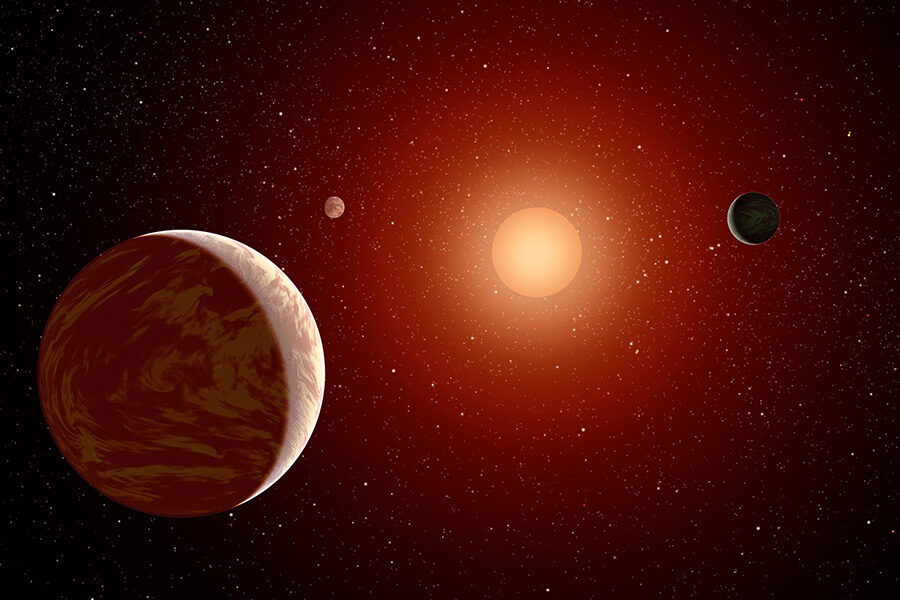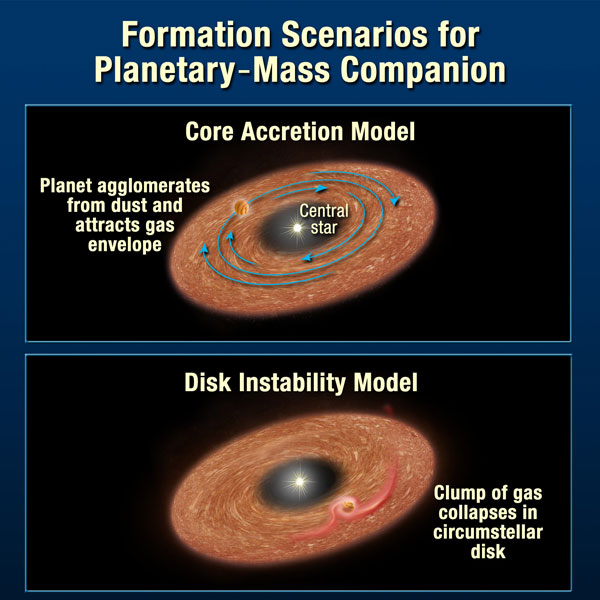Leading theories say giant planets shouldn’t be able to form around very low-mass stars. But a new study finds that, nevertheless, they do.

NASA / JPL-Caltech
In 2019 astronomers found something strange — a gas giant orbiting a low-mass star, an M dwarf dubbed GJ 3512. The discovery was an anomaly, because there shouldn’t have been enough material around the star to form such a big planet in the first place.
Now, in a new study in the Monthly Notices of the Royal Astronomical Society led by Edward Bryant (University College London), astronomers have identified fifteen possible gas giants orbiting low-mass stars. The 2019 discovery, it appears, is not unique and instead calls standard planetary formation theories into question.
The core accretion model of planet formation has two phases: First, planetesimals collide and stick together, becoming rocky cores the size of a few Earth masses. Then they start to gather large amounts of gas around themselves. This theory works well in simulations of most star systems, including our own. But low-mass stars host similarly low-mass planet-forming disks. So how can they make giant planets?
Astronomers proposed several ideas to explain the existence of GJ 3512b. Maybe the planet wandered in from elsewhere, or maybe it came together via another formation pathway, such as disk instability. In the latter alternative, gas giants form in one go, though this ought to happen farther from the host star. Nevertheless, interesting arguments were put forward to support the idea for this particular case.

: NASA / ESA / A. Feild
Bryant’s group, however, showed that the planet isn’t unique. They analyzed data from the Transiting Exoplanet Survey Satellite, including more than 91,000 stars with less than half the Sun’s mass, and identified 15 with giant planets or planet candidates in close orbits. So while the occurrence rate is low — only 0.2% — it’s greater than the null rate astronomers had previously assumed.
Bryant and his team also tried to model the two main formation pathways with the planets in question, but they found that neither worked well to explain how these systems came to be. “Maybe there is a third formation method going on that we don't know about yet,” Bryant speculates. “Or it is one of the main two, but it's operating in extreme circumstances.” There may be several ways that planets could form.
To improve our planetary formation models, we need more data on more planetary systems in different stages of evolution. The observations we have are limited by the methods we use to detect planets, including the radial velocity method, which is good for finding planets around low-mass stars, and the transit method, which works best for planets orbiting close-in to their star. But there are many different kinds of planet systems out there, and we’ll need more and different techniques to find them all.
Martin Schlecker (University of Arizona), who was not part of this study, says that microlensing might be one solution. “Gravitational microlensing is an exoplanet hunting method made more feasible by instruments like the upcoming Nancy Grace Roman Space Telescope,” he says.
Microlensing relies on the gravitational force of a foreground star, which bends and focuses light coming from a distant background star. If there’s a planet around the foreground star, it will leave a distinct fingerprint in the amplification of the collected light. This method can detect planets orbiting far out from Sun-like stars, and can even find rogue planets that aren’t gravitationally bound to a star at all. It can thus fill in some gaps in the planetary census.
Everyone loves a mystery, and right now astronomers are thrilled that neither core-accretion nor disk instability seems to work in the case of these rare gas giants around tiny stars.
 6
6









Comments
Rod
April 11, 2023 at 1:58 pm
Very good report on this giant exoplanet, GJ 3152 b. My observation. These sites report properties for GJ 3512 b. http://exoplanet.eu/catalog/gj_3512_b/, and https://exoplanetarchive.ipac.caltech.edu/overview/GJ%203512%20b#planet_GJ-3512-b_collapsible
Applying the disc mass using MMSN to 0.123 Msun host star, total gas and dust could be about 409 earth masses. GJ 3512 b is about 0.46 Mjup or about 146 earth masses. Such differences in a postulated disc mass around the parent star and exoplanet mass does suggest planet formation problems.
You must be logged in to post a comment.
Anthony Barreiro
April 11, 2023 at 10:11 pm
There are binary red dwarf systems, and binary red dwarf / brown dwarf systems. Why not red dwarfs with gas giant planets? It seems like a continuum. What is different about the formation of star / gas giant planet systems compared to the formation of red dwarf binaries or red dwarf / brown dwarf binaries? This is a sincere question. Obviously I'm missing something.
You must be logged in to post a comment.
louis-robinson
April 18, 2023 at 12:03 am
I will admit to having paid more attention to the deaths of stars than their births - dead stars make for _much_ more interesting DSOs - but if my understanding is correct, it's not really a continuum, but separate mechanisms.
If I have it right, the current scenario is: Multiple stars will form when a collapsing cloud fragments into several cores each of which accretes a portion of the cloud on its own. And there's a limit on how close they can be, with really close binaries forming by later orbital interactions. Planets form from materials that 'miss' the protostar and settle into a disk around it, via the mechanisms cited above. In a multiple system each protostar has its own disk, and a much wider one can form around the entire system, but each of them has a mass that is a percentage of the mass of the central object - a fairly small percentage, at that, IIRC. So there's not supposed to be enough mass around a small protostar to form a large planet, especially since none of these mechanisms is particularly efficient.
Supposedly, there's a minimum mass that can form an object by self-gravitational collapse, and the limit is somewhere around the bottom of the brown dwarf range; anything smaller has to be seeded out of the material already concentrated in a disk accumulated around a larger protostar. It may well be that what we're seeing is evidence that that supposition is wrong, and it is possible to form a 'binary' system where one object is in the planetary-mass range. Or, perhaps, that it's possible for the protostar to fission much later in the process than is generally thought to be the case. Either way, it would probably be the result of special conditions that don't turn up in any of the current simulations.
You must be logged in to post a comment.
Dr Jay
April 23, 2023 at 6:39 pm
Good job comparing the current models for planet formation. Note that 15 large planets around 91,000 stars give a rate of 0.016%, which rounds to 0.02%, not 0.2% as quoted. Also, the null hypothesis is somewhat overstated. The probability of a high-mass planet orbiting a low-mass star is small but not zero.
You must be logged in to post a comment.
Monica Young
April 25, 2023 at 11:07 am
Hi Dr Jay,
The occurrence rate takes into account multiple factors, including the fact that we only see a fraction of all planets via the transit method! So it's not simply a matter of dividing 15 by 91,000 — the abstract of the paper confirms it is 0.2% for the full sample: https://academic.oup.com/mnras/article/521/3/3663/7069338.
You must be logged in to post a comment.
Monica Young
April 25, 2023 at 11:10 am
Also, the null hypothesis is in fact zero for very low-mass stars! Specifically, stars with less than half the Sun's mass ought not to make giant planets at all, at least not via the core-accretion model. So if giant planets exist *at all* around these stars, their existence suggests a different formation mechanism. See the fourth paragraph of the paper's introduction for more details on this if you're interested!
You must be logged in to post a comment.
You must be logged in to post a comment.